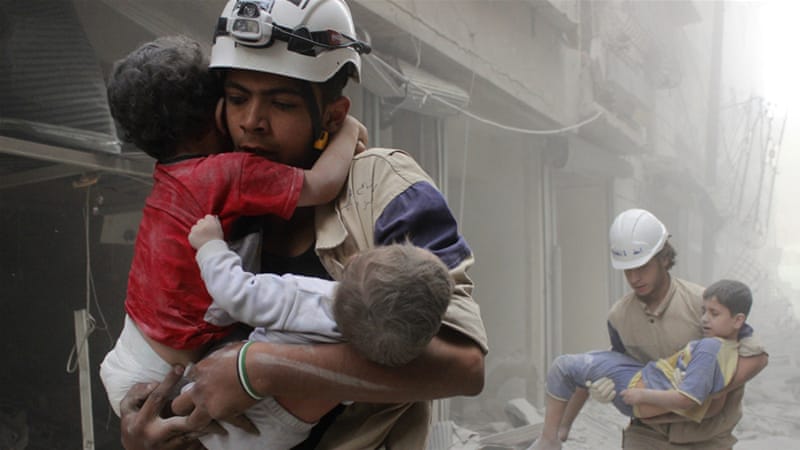Syria: Regime Barbarity, Rebel Humanity
"Honouring a group of brave and for the most part, anonymous humanitarians represents the true values of the Nobel Peace Prize."
Wendy Chamberlain, president, Middle East Institute, Washington
"We called out: 'We are the Civil Defence. Is anyone able to hear us?'. They were on the first floor, with four floors above them, but they were protected by the ceiling, which had collapsed at a slant"
"People are dying, and we run toward death."
Mahmoud Fadlallah, Syrian Civil Defence

"They are made up of former bakers, builders, taxi drivers, students, teachers, pretty much anything apart from rescue workers."The Syrian Civil Defence group, now called the White Helmets resulting from the headgear they have effected; helmets to protect them from falling rubble when they enter bombed-out buildings, white signifying that they come in peace with only rescue on their minds, now number three thousand volunteers. Their work is the mounting of searchp-and-rescue operations in wartime conditions reflective of a broken country mired in a civil war that their president has imposed upon its civilian population.
"They are all a very diverse and disparate group of individuals, all of whom made individual choices about what their contribution to the revolution is going to be. They all had the choice whether or not they want to pick up gun, to become a refugee - but they've all made a choice to instead pick up a stretcher."
"It started with the regime bombardment of areas that were being described as liberated so by the end of 2012, areas in northern and southern Syria the regime had pulled out of areas and that gave the regime the space [...] to start bombing civilian communities."
"From within those communities emerged... individuals, who, when a bomb fell down on the street, would run out and try to help their neighbours, and they did so without training and without equipment."
"In the early part of 2013, a group of leaders from northern Syria came out and painted this very clear picture that communities on the ground were being very heavily bombed, and they needed support."
James Le Mesurier, founder, Syrian White Helmets program
Since it is regime forces bombing areas held by the rebels who have been able to hold onto part of Aleppo only with the aid of foreign Islamist groups like Nusra whom the rise of the Islamic State of Iraq and the Levant have, by contrast, made look only moderately like terrorists, the Syrian Civil Defence operates only in the opposition areas. Where homes, schools, and hospitals are just as likely to be barrel-bombed as any areas that the Syrian military may believe the rebels have their headquarters.
Wendy Chamberlain of the Middle East Institute saw fit to nominate the White Helmets to the Nobel committee for the Nobel Peace Prize. They have chosen not to fight, but to save the lives of the vulnerable who have been targeted by a regime whose carnage has become legendary, rivalling the atrocities committed by the Islamic State, a regime which has in fact, slaughtered infinitely greater numbers of Sunni Syrians than ISIL has condemned to a barbaric death its assumed enemies.
Theirs truly has become the self-assigned "most dangerous job in the world", as their admirers assert. And nor are government forces ignorant of the work they do. That very work, abandoning personal safety to the more pressing imperative of making a heroic effort to find the wounded under the rubble left by explosions and to bring them to safety and medical care, has made them a target of the Syrian government forces.
That targeting is distinguished by a routine whose technique has been dubbed "double tap" attacks. In the wake of an attack, government warplanes have taken to circling about awaiting the arrival of the White Helmet forces to strike the same target a second time with the intention of victimizing the rescuers on their arrival at the scene of the first impact.
"Frequently, in between those first two bombs, there is a very narrow window - 15 minutes or half an hour - where they often find people, aren't able to get them out, and then a second bomb comes. Many… have been injured because they haven't gotten away quickly enough, or they have chosen to stay with the people they are trying to rescue", explained Mr. Le Mesurier.
One White Helmet volunteer, Khaled Omran Harrah, involved in the 2014 rescue of a ten-day-old infant trapped for ten hours in an after-blast rubble, out more recently with Mr. Fadlallah and five others at a blast scene were working on the difficult extraction of a survivor from the remains of a building when they were attacked by a "double tap". Taking shelter where they could, Harrah was killed, while the others received shrapnel wounds. The man they hoped to rescue died.

<< Home